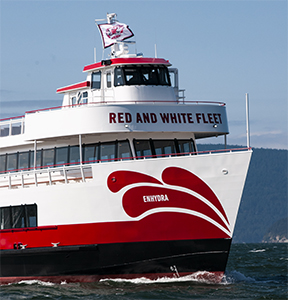Northern California has long been a hub for innovation, so it’s probably fitting that the greenest large excursion boat in the United States is now based at San Francisco’s Pier 43 1/2.
Red and White Fleet took delivery of the 600-passenger Enhydra in early September. The aluminum monohull is outfitted with a lithium-ion battery-electric hybrid propulsion system supplied by BAE Systems, giving the ship the capability of extended cruises in electric mode.
All American Marine of Bellingham, Wash., built the 128-foot vessel using plans developed by naval architect Nic de Waal at Teknicraft Design in Auckland, New Zealand. Enhydra is the largest hybrid excursion boat in North America and one of just a handful of passenger vessels operating with similar propulsion worldwide.
Enhydra also has numerous amenities intended to improve the passenger experience. These include oversized windows, a powerful heating and cooling system capable of withstanding San Francisco’s fickle weather, a premium sound system and Sika poured floors.
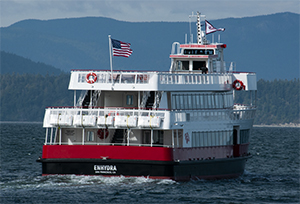 |
|
Red and White Fleet initially considered designs for a steel monohull for Enhydra, but opted for aluminum due to cost savings in construction and future maintenance. Fully loaded, the boat can cruise at 13 knots. |
“We built a 21st-century vessel, and we wanted to have 21st-century technology on it,” Joe Burgard, vice president of operations for Red and White Fleet, said in a recent interview. “We are pretty confident the maritime industry wherever possible will move toward electrification.”
Founded in 1892 by Thomas Crowley, Red and White Fleet operates five vessels around San Francisco. Current owner Tom Escher bought the company in 1997. Burgard described him as a “true visionary” who is committed to moving toward a zero-emissions fleet by 2025.
“The hybrid technology is the easiest gateway to going full electric because we already have the full electric architecture on board the vessel,” Burgard said. “We are right on that leading edge of this change in the industry. We weren’t the first, but we are the first of this magnitude.”
For its first newbuild under Escher’s ownership, Red and White Fleet planned for an efficient, environmentally sound vessel. But the hybrid propulsion and aluminum hull were not part of those original plans. Those features came later, from the operator’s desire to have a bow thruster, Burgard said.
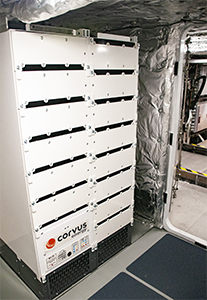 |
|
Two Corvus Energy lithium-ion battery packs reduce fuel consumption and operating noise. |
Despite some initial reluctance, Red and White Fleet decided on aluminum over steel for the hull. It also embraced hybrid propulsion over conventional diesel main engines, in part after learning the potential operational benefits. The system burns substantially less fuel, produces less emissions and runs virtually silent through the water in electric mode.
Another selling point, Burgard said, was the BAE HybriDrive system’s long history on city buses and other vehicles. While relatively new on boats, it has a proven track record from road uses.
The twin-screw Enhydra has independent propulsion units on its port and starboard sides. Each has a generator paired with a 410-hp Cummins QSL9 diesel engine, as well as a propulsion power converter and a house load power supply and control system, according to the shipyard.
Twin 80-kW lithium-ion battery banks power shaft motors that turn two 48-inch props through reduction gears. The generators can provide simultaneous power to the shafts to increase output, or provide power to charge the batteries supplied by Corvus Energy.
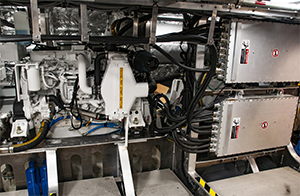 |
|
At the heart of Enhydra is its hybrid propulsion setup that teams a pair of Cummins QSL9 Tier 3 diesel engines with BAE Systems’ HybriDrive system. The box on the upper right houses the ancillary power control components, and the box on the lower right is the propulsion control system. |
Each genset has 300 kW of output, which is equivalent to about 400 hp. Similarly sized excursion boats typically have at least 20 percent more power, although Burgard said Enhydra benefits from its efficient hull and variable engine loads. During a typical cruise, the engine load averages about 40 percent.
“That operating profile will mean the generator will change in speed and sometimes go in all-electric mode,” he explained. “The vessel is designed to give us the ability to force the all-electric mode, and once the batteries get down to a certain state of charge, the generator will come on and ensure we don’t damage (them).”
Although the engine room is more sophisticated than those on ships powered by conventional diesel engines, Red and White Fleet said it has engineering personnel who are well trained on the new systems. It also has faith in its shoreside support team and vendors, Burgard said.
Most Red and White Fleet cruises last an hour. Depending on tidal currents, weather and other factors, Enhydra can run at least half of the time on battery power, producing no emissions. Typical sunset cruises that last twice as long but run at slower speeds can operate the entire time in electric mode.
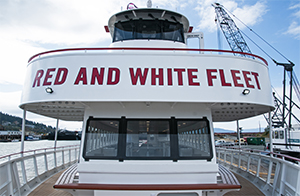 |
|
Passengers can enjoy views of San Francisco Bay and the cityscape from all three decks. |
Red and White Fleet is already exploring battery upgrades for Enhydra to run entirely on battery power. It’s also installing shoreside fast-charging stations that will allow for longer cruises without the need to run the generators to charge the batteries. In the near future, the vessel could be the only zero-carbon emissions passenger cruise vessel in the U.S.
The vessel has performed better than expected so far. During the delivery voyage from Washington, Enhydra burned about 8.5 gallons of fuel an hour while making 8.5 knots.
Delivery Capt. Pat Carson praised Enhydra’s handling and overall design during the 120-hour voyage. He said the offset-mounted, fishtail-shaped rudders improved the vessel’s performance while operating on a single engine.
“Normally, on a more traditionally designed boat, if you are on one engine, you need five to 10 degrees of rudder to compensate,” said Carson, a relief captain for Red and White Fleet who also handles yacht deliveries. “This boat is one degree. It’s almost unnoticeable.”
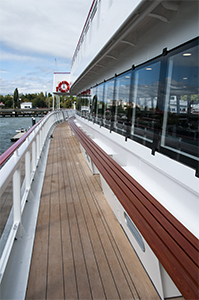 |
|
The second level has a full wraparound deck with access to an enlarged foredeck. |
Enhydra operated on a single engine in the open ocean for several hours during the delivery voyage. “You almost didn’t know,” Carson said. “The boat was as stable and almost as steerable as it would have been on two engines. I think the designer nailed it.”
Naval architects at Teknicraft approached the project with several key objectives from Red and White Fleet. In particular, the operator wanted a 600-passenger vessel with three decks, de Waal said. The third deck needed to safely hold at least 200 people, and emissions had to be as low as possible.
Achieving these objectives, de Waal said, required ditching steel for an aluminum hull, installing the BAE hybrid propulsion system and using a hull form that required less power than conventional vessels to maintain speed. He met the design criteria by reducing lightship displacement, which in turn reduced drag while underway.
“We used our experience together with computational fluid dynamic (CFD) analysis to design a hull shape with minimal wave resistance, thereby further reducing the power requirement to propel the vessel,” de Waal said in an email from his home in New Zealand.
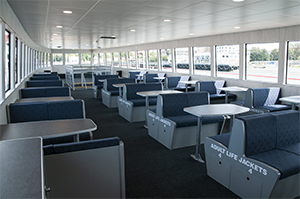 |
|
Interior seating on Enhydra’s second deck is complemented by an array of tables and by windows that provide 360-degree views. |
“The hull shape was also critical in terms of stability,” he continued. “The client wanted to be able to carry at least 200 passengers on the upper deck, and we needed to shape the hull to provide the best stability without compromising on the resistance of the hull.”
Enhydra exceeded Red and White Fleet’s design criteria during sea trials. The U.S. Coast Guard certified it for 300 people on the third deck — 50 percent more than the operator initially sought. The vessel’s hybrid system also performed 40 percent better than predicted.
All American Marine built Enhydra at its new facility on Bellingham Bay. When construction began in June 2017, it was just the second hull underway at the 57,000-square-foot facility. Workers had to get accustomed to the new site while installing and testing a “revolutionary” new engine system, according to spokesman Bronson Lamb. The yard is extremely proud of the finished product, he said.
“Riding on this newbuild during sea trials, with almost a silent experience, really was a great moment for our team here,” Lamb said. “We also designed the vessel to accommodate future upgrades to the battery system, thus creating the possibility for a zero-emissions vessel.”
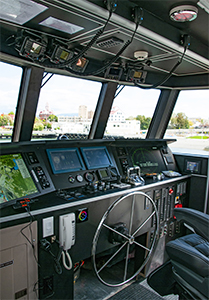 |
|
Navigation and communications equipment on the bridge includes an expansive package from Furuno, including radar, echosounder, through-hull transducer, GPS and AIS. |
All American is building two high-speed catamaran ferries for Kitsap Transit in Bellingham, in addition to a 150-passenger hybrid propulsion ferry for the public transportation agency. The yard is also hoping to deepen its relationship with Red and White Fleet as well as other operators exploring hybrid vessels.
Although some passengers will no doubt be drawn to Enhydra for its innovative propulsion system, most will be more concerned about comforts while on board. It has three bar and galley areas and there are three heads, including a handicapped-accessible family bathroom. Like other excursion boats, it has large windows for optimal viewing. But it also has Lexan clear polycarbonate side panels that let passengers look directly through the railing spaces. The railings also have LED edge lights than can display multiple colors for a distinctive look at night.
“We have a state-of-the-art sound system on board the vessel, and we tried to make it very sleek, very clean. I would say we succeeded,” Burgard said.
Enhydra is very early into its tenure with Red and White Fleet, but the company has high hopes for the vessel. It’s also confident in the new technology and what it offers passengers, the environment and the company’s bottom line.

